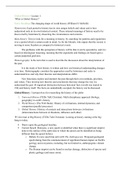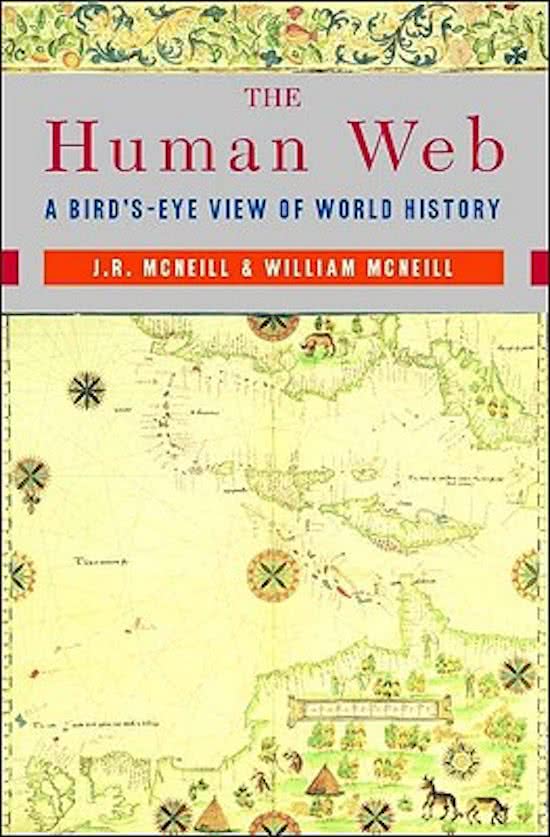Global History- Lecture 1:
‘What is Global History?’
Extra Reading: The changing shape of world history (William H. McNeill)
Historicism: Each period in history has its own unique beliefs and values and is best
understood only in its own historical context. These internal meanings of history need to be
discovered by historians by dissecting the circumstances and contexts.
Meta history: Tries to look for a meaning in history, by searching for patterns and regularities
over a period which a certain result in mind. As for the liberals, who argues that the society is
moving to more freedom as compared to historical events.
The problems with this perception of history will be that it can be speculative, and it is
based on teleological reasoning, meaning that the arguments and findings are based upon a
certain purported goal/aim.
Historiography: Is the term that is used to describe the discussion about the interpretation of
the past.
It is the study of how history is written and how our historical understanding changes
over time. Historiography considers the approaches used by historians and seeks to
understand how and why their theories and interpretations differ.
New historians explore and interpret the past through their own methods, priorities,
and values. They develop new theories and conclusions that may change the way we
understand the past important distinction between historical facts (world war started in
194) and history itself. The facts are undoubtedly accepted, the history can be discussed.
Global History: 3 perspectives for researching the history of the globe
1. Universal History (TEDx Talk Christian): Multi disciplinary approach (biology,
geography) to earth’s history.
2. World History (The Web Book): History of civilisations, internal dynamics, and
comparison (parallel processes)
3. Global History: History of contacts and interactions between civilisations
(interconnections between civilisations, influence each other)
Universal or Big History (TEDx Talk Christian): Looking at history starting at the big
bang to today.
Draws upon the geological timeline.
Current Epoch: Holocene, a new epoch is identified when there is significant imprint
done to the surface of the earth (due to which the epoch can be identified as being
different than the epoch before).
o Debate if a new epoch has arrived The Anthropocene: Proposed geological
epoch dating from the commencement of significant human impact on Earth's
geology and ecosystems, including, but not limited to, anthropogenic climate
change.
o The Human imprint can be found in nuclear damage, distinction of species and
plastic garbage (and many more).
,TEDx Talk: The history of our world in 18 minutes (David Christian)
Central theme of the Big History-Theory is the principle of complexity: caused by Goldilocks
conditions (those conditions that are just right to create a new development) which create
Threshold moments (the new fase of complexity that can be entered when the Goldilocks
conditions are met).
The major force that makes human beings different from other species is the Collective
Learning.
Three predominant patters in the Universal History:
1. Increase in complexity over the course of the earths 13.7 billion years of history
2. Collective learning
3. Control over bio-spheric resources
Christian (speaker) uses a very broad perspective on history, by including the biology,
chemistry, geology, earth sciences, astronomy, and cosmology. The aim of Christian is to
create global citizenship (so, his theory has a normative character).
The Universal Historians believe that by looking at history from such broad
perspective, they will teach society about the dangerous consequences of our astonishing
ecological and technological creativity and will so aim to facilitate a tolerable future for
humanity.
World History: Seeks to record the whole significant and knowable past; recording what
we know up until this point.
Historiography of World History: Ingredients necessary to understand where the theory of
World History comes from.
Religious (Christin, Jewish) and Dynastic (Asia) rationales
o Meta History: Divine/ dynastic intervention how life would have been in
historical timeframes.
European Enlightenment, scientific revolution
Emergence of liberal version of history
o Meta history: advance of Freedom
Two main historians who used the World History Theory:
1. Oswald Spengler: Most civilisations pass a certain ‘life cycle (birth, rise and decline)’,
which means that a historian can reconstruct the past and can predict “the spiritual
forms, duration, rhythm, meaning and product of the still unaccomplished stages of
our Western history.
a. Thereby he argued that the spirit of a culture can never be transferred to
another culture. Since the Western culture was created and developed in a new
stage, the culture would remain its identity.
b. Certain trajectory of the natural and inevitable cycle of civilisations.
c. Civilisations Spengler identified: Classic Greek- Babylonian- Chinese- Indian-
Arabic- Western
2. Arnold Toynbee: Presented history as the rise and fall of civilisations rather than the
history of nation states or ethnic groups.
, a. He identified populations according to their shared culture, rather than
ethnicity or national boundaries.
b. Challenge-and-response Criteria: In which Toynbee argued that civilisations
arose in response to some set of challenges of extreme difficulty, when
"creative minorities" devised solutions that reoriented their entire society.
The disappearance of Universal and World History
The requirements of science and the ‘Rankea’ revolution
The rise of nationalism the need to invest in national history instead of global.
Fragmentation of scholarship, ever increasing specialisation
Global History: The largest and most inclusive framework of human experience.
Main actor: A civilisation, since historical change is largely provoked by encounters
with strangers, followed by efforts to borrow. Evidence of contacts between separate
civilisations will therefore alert world historians since it can stimulate social change.
Thus, the min stimulator of social change is the encounters of separate civilisations.
Two examples of Global History:
1. The cockatoo (picture dated from the Roman Empire 1300): Picture is the oldest in
Europe, which is remarkable since the bird originated from Australia. Illustrates that
already back then trading routes where present between the Roman Empire and New-
Guinea.
2. The ecological effect of colonialism: Shows the contact between European invaders
and the indigenous population living in the colonised area.
a. Geological effect: Germs which Europeans took with them to the new-
colonised area.
Core concerns of Global History
Connectivity and the interconnected word
Mobility exchange
Processes transcending borders and boundaries
Circulation of people, ideas, things, and institutions
Global History is an example of historicism (since global historians rely on the work of others
to invest the historical events) and meta history:
Main patterns in global history (which indicates the existence of the meta history) are:
o Civilisational interactions (The Web Book)
Biological/ecological, cultural
o Collective Learning (TEDx Talk Christian)
, Global History- Lecture 2 (Chapter 1/2/3): Great Debates I - Civilization
Core argument of The Human Web
Form: Meta-History The McNeil’s argue that the Human Web was created by the
ever increasing interaction over the course of the Human evolution, in which exchange
and competition gave shape to the Human Web.
Pattern: ‘Human webs’ shaped history The exchange and spread of information and
items through webs, and the human responses to them, is what shapes history.
Dialectics / Motors of change: Webs combined competition and cooperation, within
and between webs, causing societal progress. This exchange is the motor behind
history.
Core of this Week: ‘Constant tension between nomadic and sedentary civilizations’
The definition of a Web: A set of connections that link people to one another
Connections include kinship, friendship, chance encounters, common worship,
economic exchange, ecological exchange, political cooperation, rivalry, enmity, or
military competition.
Communicating information: Copied or discarded, but can form a motor of change
Characteristics:
o Cooperation and competition
o Comparative advantage: The Webs grow since they have advantages
compared to other human groupings.
o Organisational features: Rule and leadership, how are Webs organised and
shared identity.
o Communications: Within and without the Web, with language and signs.
An overview of the Human Web:
1. The Human Apprenticeship (200,000- 12,000 B.C.E.)
a. First communities who lived together:
i. Control over fire
ii. Song, dance, and art
iii. Speech and common meaning
iv. Complex tools and technology
b. Agriculture; opportunities and risks
i. Opportunity
1. Settlement, organisation, solidarity
2. Population growth
3. Artefacts, astronomy - development
ii. Risks
1. Disease
2. Warfare with non-settled groups
2. The First World Web (12,000- 3500 B.C.E.)
a. First examples of major civilizations
b. Agricultural Revolution:
3. The Metropolitan Web (3,500 – 200 B.C.E.)
a. Axial Age






